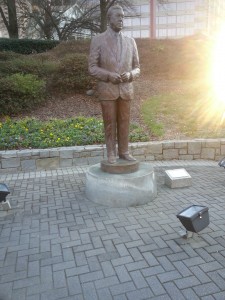The Woodruff Arts Center is located in Midtown Atlanta, Georgia. The center was built in 1968 by award winning architect Richard Meier. Robert Woodruff, who was a main benefactor for the site, intended to pay homage to the art and civic leaders of Atlanta and provide programs for youth and their families. Although the center was built with the intention of building community it does appear to exclude the lower class and homeless.
Tag Archives: Exterior
Digital Advertisement
The Woodruff Arts Center has several modern design elements such as sleek geometric architecture and and digital environment. The digital environment within the exterior of the center displays upcoming events, sponsorship, and other intriguing information to attract ongoing traffic. In the video, the digital environment and the exterior coexist to attract its intended users through visuals and graphics.
Bronze Statue
This is an image on a bronze statue of Robert W. Woodruff designed by Nobuhito M. Matoba. The statue symbolizes Woodruff’s contributions to the Art Alliance, renamed Woodruff Arts Center. The statue stands in front of the Symphony Building and alongside a sculpture designed for the Olympics. The center commemorates a man who seemed to care a lot about how his actions influences his community in terms of architecture and community service.
Woodruff Arts Center Exterior
This is an image on the entrance of the High Museum of Art/ Woodruff Arts Center located in Midtown. The architecture of the center is modern and geometric. This design on the center can be intimidating because it appears to cater to the middle and upper class despite being easily accessible on public transit.
Benches and Trashcans
At the Woodruff Arts Center/High Museum of Art, the architecture appears to be inviting of its surrounding community (big open windows, bright friendly colors), however there are also features that seem to be a method of exclusion. For instance, as shown in the image above the benches at the center have bars that would prevent the homeless from sleeping, an example of discrimination featured in Schindler’s article Architectural Exclusion: Discrimination and Segregation Through Physical Design of the Built Environment. In addition to barred benches, the center also has locks on trashcans designed to exclude the homeless.



